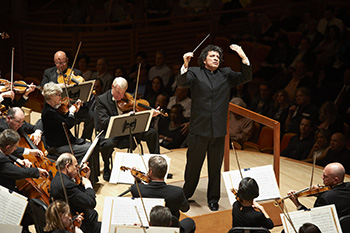
Photographer: Roger Mastroianni
When you match a buoyant conductor hitting his stride with a premium orchestra sounding like they just returned from a fine vacation, you are reminded that there are simply no recordings that can match the experience of the live performance. Listening to the classics through the acoustic lens of the John S. and James L. Knight Concert Hall powered by the baton of Giancarlo Guerrero and The Cleveland Orchestra, is a privilege and a must for any serious South Florida concertgoer.
Guerrero, in his fourth year as Principal Guest Conductor of TCO, has matured from a carefully competent maestro to an ebullient force of nature, capturing and captivating the audience with an infectious smile, boundless enthusiasm and natural command that did not let up throughout the entire evening’s program.
Opening the TCO 9th season to a full house on Nov. 14 and 15 at the Adrienne Arsht Center for the Performing Arts, Guerrero instantly disconnected the audience from their day-to-day and connected them to the bustling Carnival with Tchaikovsky’s Capriccio Italien.
The opening bugle call quickly blossomed from a sense of foreboding into a bouncy Italian street song, the lively waltz passing through the oboes, bassoons, flutes and trumpets to the full orchestra like a festive oom-pah band. The piece turned into a scamper with a Russian element and some Spanish spice, then bloomed into the joyous melody again before turning the corner and making the sprint to the finish line. Guerrero’s perpetual smile, head bobbing and jumping on the podium to bring TCO down the home stretch of this whimsical fantasy brought howls and applause from the crowd.
Guerrero teamed up with the trim and handsome guitar soloist Miloš Karadaglić for Rodrigo’s elegant Concierto de Aranjuez (which, incidentally, had its 1959 American premiere with TCO under conductor Robert Shaw).
Rodrigo’s muse was the 16th century gardens of Aranjuez. He described his concerto as capturing "the fragrance of magnolias, the singing of birds, and the gushing of fountains."

Milos Karadaglic. Photographer: Lars Borges / Mercury Classics
A couple of spirited guitar strums began the three movement work, Karadaglić effortlessly passing from soft to loud as TCO echoed the plucky melody. Though the guitar rarely faces the forces of a full orchestra, at no time was Karadaglić overwhelmed by the 105 members of TCO.
The gorgeous central Adagio stays with us whenever we hear it. Jazz great, trumpeter Miles Davis (who included his take on the Adagio in his album Sketches of Spain) remarked, “That melody is so strong that the softer you play it, the stronger it gets, and the stronger you play it, the weaker it gets."
There is a dialogue, perhaps a dalliance, between the guitar and English horn at the sensuous center of this movement. Laced through the piece is a “quiet regret” articulated with arpeggios, runs and strums; Karadaglić on point, tenacious gentle and confident, explored his upper register with the precision of a watch-maker, tooling the lows with profound contemplation. TCO punctuated his every move with the melancholy required. Karadaglić emoted the cadenza with tremendous passion, at times his hands and fingers moving so quickly that they appeared as one solid piece.
When he completed his solo turn strumming on a single string and the full orchestra climaxed the theme, if a tear didn’t form in your eye, and your heart didn’t race, then you weren’t alive. The strings quietly resolved the movement as the guitar notes evaporated into thin air.
Karadaglić remained in his poised zone throughout the taut third movement. The courtly dance was a musical fabric of mixed meter stitched together with hard strumming, single notes and rolling chords which wrapped tightly around the audience.
The mechanism of TCO continues to be well-oiled – entrances were clean, soloists first rate (Robert Walters, English horn; William Preucil, violin; Franklin Cohen, clarinet; Joshua Smith, flute; Trina Struble, harp), the entire engine maintaining its high performance standard. Guerrero remained cool, relaxed and confident – his joy became our joy.
Respighi’s Fountains of Rome is a symphonic poem depicting one of Rome’s fountains at four different times of the day. TCO cascaded, bubbled, sparkled, swirled and whirled – every player participated freely, from gushing waterfalls to drops dripping languidly to the final gongs at the close of day.
The program concluded with Rimsky-Korsakov’s Capriccio Espagnol, a five movement orchestral suite furnished with Spanish folk melodies.
The first three movements were tied together, a solo clarinet sandwiched between the booming orchestra introducing the jaunty Alborada theme. A solemn second melody expressed by the horns, strings and then full orchestra, returned to the previous festive motif, the solo violin coloring it with a skipping bow.
Trumpets and horns fanfared the familiar gypsy theme in the fourth movement as the requisite violin ripped into a fine cadenza on the melody with double stops (playing two notes simultaneously). The violins, violas and cellos were then asked to strum their instruments like guitars as the full orchestra took up the melody, the flute, clarinet and bourgeoning harp each taking a sturdy cadenza. TCO unmoored the theme and Guerrero danced with a flash in his eye as the gypsy and Alborada themes merged.
In a furious sprint to the finish, castanets, dazzling percussion, solo wind and brass instruments and soaring strings conflated as Guerrero seemed to leap up from his podium and the audience joined him in mid-air.
For Cleveland Orchestra Miami’s full 2014-15 performance schedule and to buy tickets, visit www.clevelandorchestramiami.com.




